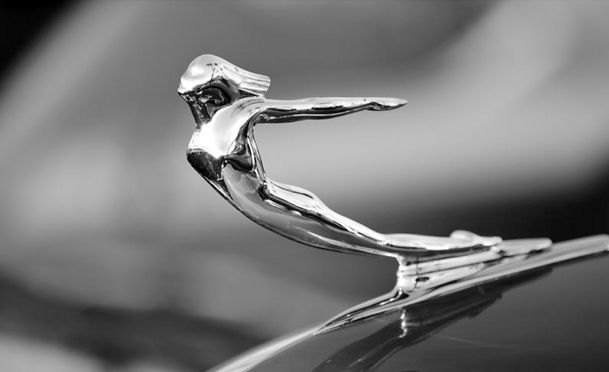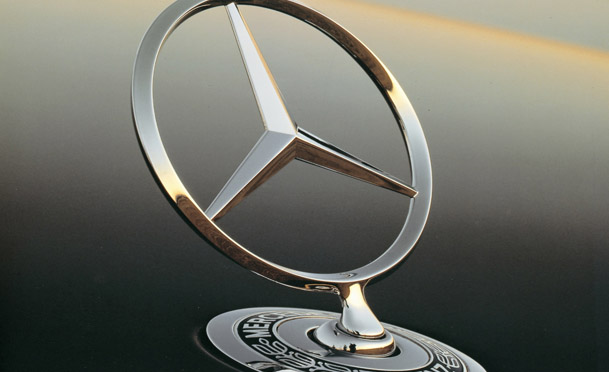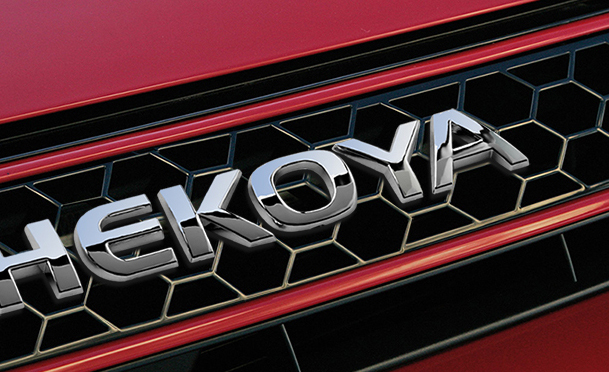History of Car Emblems
Do you know the history of car emblems?
To those who have strong interest in antique cars, car emblems (mascots) attached under the radiator caps are indispensible. They are assumed to beautify the outstanding qualities of the car and resonate the car’s unique traits such as good quality, elegance, speed or strength.

Surely, it is impossible to imagine a Rolls-Royce without the image of the Flying Lady (Spirit of Ecstasy), or a Hispano-Suiza losing its stork. Any extravagant car with a plain front carries an imperfect look. In the past, when car manufacturers had not developed assembly lines, customers used to order directly from the manufacturers to embellish their favorite cars.
Emblems express a way to differentiate cars. That’s the reason why many among the mascots were attached with wings, which represents speed, in spite of the fact that the emblems may not be bird images, but rather human figures or even letters. For example, the Bentley has the letter “B” with wings.

John Montagu can be seen as the initiator of the campaign of sticking decorational items to the front of cars in 1898. He put a St. Christopher figurine at the front of Daimler. The trend caught on among automotive enthusiasts and goldsmiths immediately launched the most popular emblems in large quantities. The time came when car manufacturers realized the importance of their own car emblems and started to order hundreds of emblems. Therefore, many car emblem manufacturing factories opened in Great Britain, USA and France. This trend became more popular during the 1920s and to this day. The Triomphe statue of Isotta-Frashini, which was chosen by an American for his own car. It has become so recognizable with this trademark that it is considered as the company’s symbol. For a long time, mascots were among the added choices when buying a car and the prices were also very reasonable.
One of the most famous emblems, among the few still in use today, is the Spirit of Ecstasy of Rolls-Royce, exclusively created for Silver Ghost by Charles Robinson Sykes in 1911.This perfect car, which was the typical of automotive manufacturing technique at that time, deserved a special decoration item. The “Flying Lady” was what most people had expected, expressing a desire, a restricted passion. The original version is Eleanor Velasco Thornton, an extremely beautiful lady with knowledge and a sense of humor. Eleanor was the lover of John Walter Edward-Scott Montagu, who was of English noble descent and was married. When Montagu suggested the sculptor, also his close friend, Charles Sykes chose Eleanor for his inspiration to beautify his own Rolls-Royce Silver Ghost.

Among the most highly prized emblems by most collectors today is the stork image of the French car manufacturer Hispano-Suiza, a favorite of many. There is a magnanimous story behind it. During WWII, Hispano-Suiza specialized in creating helicopters. On helicopters equipped with Hispano engines, pilots of the West battlefield marked their splendid victory against German air force. The car slope of the famous crew lead by Geogers Guynemer was painted with a stork image. When the war ended, Hispano-Suiza came back to the car industry and they chose the Stork mascot to represent all of their products.

Ettore Bugatti, one of the greatest people in the history of car development, only put the emblem on his only car. The emblem of the white elephant is very suitable to decorate 41 Royale. There were only 6 of 41 Royale cars that were manufactured. Each was 7m long and 3.5 tons heavy, and they were typical of race cars as well as super sports Ettore-styled ones. Rembrandt, Ettore’s older brother, who is an innately talented sculptor, spent all his life to describe the lively animals living in the Antwerp Zoo. The White Elephant mascot, created by Rembrandt, is a way to leave his own signature or mark. Ettore used it to commemorate his brother, who committed suicide because of the misfortunes in his private life.

Just like their true nature, the Germans seem quite moderate in choosing items for beautifying their cars. The three-petal flower inside the circle of Mercedes, the W of Wanderer or the Winged Ball of Horch are perfect examples of simplicity yet elegance. Nowadays, emblems made by original materials they used to be made of are really rare because they were melted by heat for metal during WWII. The same was done in occupied countries in Europe during this time.

The original emblems of manufacturers were often cheap because they were made of copper. People cast them in moulds then polished them by hand. For Spirit of Ecstasy, produced by the Sykes family in 1948, a more complicated method was applied. Due to the undeveloped technique, the final products, which depended on the environment’s humidity, was not totally the same. More complicated items such as the archer figurine of Pierce Arrow or Ikarus of Farman were cast part by part. As time went by, emblems changed in shapes. Emblems which were vulgar no longer existed, and ones which were rudimentary become more polished. Over time, more versions with valuable precious materials such as silver,appeared. Even the Spirit of Ecstasy, which seems to be the original at first glance, underwent 11 times of change. Some companies do not only use one emblem but also design many models for different cars. For example, the Eagle of Chevrolet is changed every year.
The inexhaustible wings

Designed by Rei Yoshimara in 1997, this logo is the image a bird’s full wings, representing speed, flexibility, strength and stability. The cooperation between the flying wings and the surrounded circle implies the message Mazda wants to express to its customers: as the inexhaustible bird wings, Mazda flies higher, farther on the way to conquer peaks that many wish to reach.
The royal blue

The letters on the Ford 45o model emblem are inclined with the styled F and D. This made it look soft, soaring, expressing fineness and desire to reach higher and further. The whole logo is embossed, representing strength and prosperity. The oval outside is alighted with silver, representing the remarkable technique of Ford products. Of course, we cannot ignore its one –hundred- year- old blue color, which is the color of friendliness, immortality and which always cares for the consumers of the Ford Motor Company.
The blue fan of Bavaria

The Germans are known for their firmness in their choices. This explains why BMW sticks to the image of the famous white and blue fan during their development history. BMW understands very well that nothing can represent vitality, faithfulness and immortality better than the color of the national flag, that nothing can be as memorable as the combination between a simple cube and familiar color. Therefore, the logo of BMW means that BMW is the company of Bavarian people, which means BMW will survive and develop together with its nation during the most difficult times in history. The gray color of the surrounded circle also represents wisdom, power, flexibility and, above all, the bright future of most luxurious cars in the world.
The three silver intersectional eclipses

The logo including 3 intersection eclipses (stand for 3 heats) exemplifies the care Toyota saves for their customers, the quality of their products, and the incessant effort to develop techniques. Experiencing 70 years with many changes, Toyota is still walking on its own path, the path to perfection in the tradition of the country of the rising sun.
The three-petal star of Mercedes-Benz

The three-petal-star logo of Mercedes stands for the burning desire to make their products dominate everywhere in the world: on the earth, under the ocean and even in the sky. Simple, elegant, highly symmetric, and easy to remember, the logo itself fulfills the function of the image – the most considerate introduction to the public as one of the most prestigious car manufacturers in the world, Mercedes-Benz.
The champion horse on the F1 race track

The logo of Ferrari is the symbol of the combination of the talent of one hero (the hero Francesca Baracca ), the tradition of the area (Modena city) and the culture of a country. That may be the reason why during the last 76 years, that logo has accompanied, represented Ferrari in any circumstance. In the present, to answer the question of the F1 car race fans, “Who will beat Ferrari?”, people in Scuderia response by “Who have the capability to make the horse on the logo stop galloping?”
Hekoya The Branding ICONS

Today, Hekoya has revolutionized the art of creating emblems by using advanced chrome manufacturing techniques. As brilliant as silver, chrome is made using state-of-the-art plating with the finest craftsmanship in the business. Hekoya’s chrome branding now also includes color chrome, bringing a dynamic new dimension to what you can put on your vehicles and changing the function of car logos and emblems, which has been an automobile-decorative trend practiced worldwide today. Hekoya’s color chrome feature is popular for simple decals or actual replacement emblems for factory originals.
Increased popularity of having custom car emblems is due to a number of reasons, including and not limited to launching a marketing campaign to make one’s car stand out amidst other cars in a pack of similarly shaped models. Most car importers are likely to use unique models to promote their own brand which not only helps enhance a car’s appearance, but also serves as a great outlet for artistic expression
A personalized touch on your car makes people feel connected. It really ties people together and gives you a strong sense of branding.

